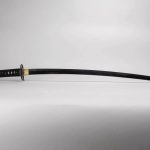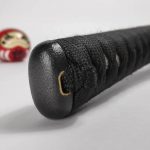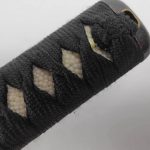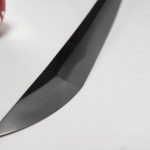4 Gourds Katana
Pro & Con'saccording to myself ;)
- Limited Edition
- Light weight
- Nice steel grain
- Good balance
- Not for cutting harder targets
In Stock
- Free shipping within the EU & USA
- 90 Days Return Policy
- Personal Quality Check
The Blade
Unlike the dharma wheel katana, there’s no specific story behind the choice of the blade. The idea here was to create a light & agile katana for Iai / dojo practitioners in the first place that looking for a nice shinken 😉
With a weight of more or less 950 gram and a blade that measures 74cm (tsuba to tip) with a point of balance around 16cm from the tsuba I think the mission is accomplished.
The only negative point I can think of from an Iai / dojo practioner point of view is that:
- it’s not available in different lengths
- doesn’t come with a hi (so no loud tachikaze)
Adding a hi woud have taken too much strength out of the blade in my opinion. But never say never…although the original plan is still to keep this a limited editon that won’t be offered again once sold out.
The blade is forged out of orishigane (self-made steel) features a Gunome-Midare hamon and has a geometric yokote. Carbon content in this blade is somewhere between 0.6%-0.70% and the higher grade polish is revealing the steel grain in a subtle yet prominent way. The kissaski is geometric.
The Tsuba
For years i have this design saved in my online gallery and this was the perfect project to actually use it. It represents 4 gourds (Hyotan).
Besides being a plant / fruit and a Sake Flask (Tokkuri ) is it a symbol with a few different meanings.
- In general, it is seen as a symbol of good luck and is often used as a decoration during the New Year.
- The gourd is also a symbol of longevity, as it is a long-lived vine, and is often given as a gift to elderly people or to celebrate a long life.
- Additionally, the gourd is a symbol of fertility, and is sometimes given as a wedding gift.
- In Buddhism, the gourd is often depicted in artwork as a symbol of the Buddha’s teachings, as it is said that the Buddha’s teachings are like a gourd, providing sustenance and nourishment for the soul.
Hideyoshi Toyotomi, a powerful feudal lord and military leader in Japan during the late 16th century,is often depicted holding or wearing a gourd.
He also used a gourd motif on his battle standard.
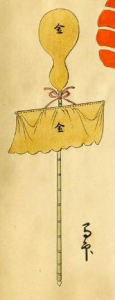
Each time he won a battle, he would add another gourd to the standard. This standard, known as the “Sennaribyoutan,” which means one thousand gourds growing on a tree, became a symbol of victory.
In the book “Legend in Japanese art” by Henri L. Joly (1908) there’s a nice little story about how Hideyoshi came to adopt the gourd standard:
“At a fight between Toyotomi HIDEYOSHI, and another of the Kuge, or retainers of OTA NOBUNAGA, Hideyoshi having no standard to carry before him, improvised one by plucking a gourd plant by the roots and using it as a pennon. After beating his opponent he adopted the gourd as a standard,vowing that he would add to his banner (Umajirushi) one gourd for eac victor he wo thereafter.”
True or false, it’s a good story 😉
If you’re interested in the book, you can read & download it here.
Rest of the fittings & saya
Not much to say here, just a plain & simple higo style fuchi kashira 😊 and a bamboo themed menuki.
The saya comes in a black gloss lacquer (Kuroro) with horn koiguchi, kurikata and kojiri.
Video's
In our attempt to make a few ‘light’ models to satisfy to iaido practitioner we forgot that there are still people who like to perform tameshigiri in their dojo (or at home) .






